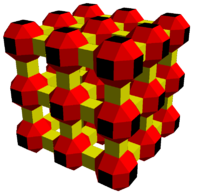Infinite skew polyhedron
In geometry, infinite skew polyhedra are an extended definition of polyhedra, created by regular polygon faces, and nonplanar vertex figures.
Many are directly related to a convex uniform honeycomb, being the polygonal surface of a honeycomb with some of the cells removed. As solids they are called partial honeycombs and also sponges.
These polyhedra have also been called hyperbolic tessellations because they can be seen as related to hyperbolic space tessellations which also have negative angle defects.
Regular skew polyhedra
According to Coxeter, in 1926 John Flinders Petrie generalized the concept of regular skew polygons (nonplanar polygons) to regular skew polyhedra.
There are 3 regular skew polyhedra:
- {4,6|4}: 6 squares on a vertex (related to cubic honeycomb, constructed by cubic cells, removing two opposite faces from each, and linking sets of six together around a faceless cube.)
- {6,4|4}: 4 hexagons on a vertex (related to bitruncated cubic honeycomb, constructed by truncated octahedron with their square faces removed and linking hole pairs of holes together.)
- {6,6|3}: 6 hexagons on a vertex (related to quarter cubic honeycomb, constructed by truncated tetrahedron cells, removing triangle faces, and linking sets of four around a faceless tetrahedron.)
Their vertex figures are skew polygons, zig-zagging between two planes.
Here are some partial representations, vertical projected views of their skew vertex figures, and partial corresponding uniform honeycombs.
 {4,6|4} |
 {6,4|4} |
 {6,6|3} |
 4.4.4.4.4.4 |
 6.6.6.6 |
 6.6.6.6.6.6 |
 Cubic honeycomb |
 Bitruncated cubic |
 Bitruncated alternated cubic |
Prismatic regular skew polyhedra
There are also two regular prismatic forms, disqualified by Coxeter (among others) from being called regular because they have adjacent coplanar faces.
- 5 squares on a vertex (Two parallel square tilings connected by cubic holes.)
- 8 triangles on a vertex (Two parallel triangle tilings connected by octahedral holes.)
Beyond Euclidean 3-space, C. W. L. Garner determined a set of 32 regular skew polyhedra in hyperbolic 3-space, derived from the 4 regular hyperbolic honeycombs.
Semiregular skew polyhedra
There are many other semiregular (vertex-uniform) skew polyhedra, discovered by A.F. Wells and J.R. Gott (he called them pseudopolyhedra) in the 1960's.
 A prismatic semiregular skew polyhedron with vertex configuration 4.4.4.6. |
File:Skew polyhedron 4646.png A (partial) semiregular skew polyhedron with vertex configuration 4.8.4.8. Related to the omnitruncated cubic honeycomb. |
 A (partial) semiregular skew polyhedron with vertex configuration 3.4.4.4.4. Related to the Runcitruncated cubic honeycomb. |
References
- Coxeter, Regular Polytopes, Third edition, (1973), Dover edition, ISBN 0-486-61480-8
- Coxeter, The Beauty of Geometry: Twelve Essays, Dover Publications, 1999, ISBN 0486409198 (Chapter 5: Regular Skew Polyhedra in three and four dimensions and their topological analogues)
- Coxeter, H. S. M. Regular Skew Polyhedra in Three and Four Dimensions. Proc. London Math. Soc. 43, 33-62, 1937.
- Garner, C. W. L. Regular Skew Polyhedra in Hyperbolic Three-Space. Canad. J. Math. 19, 1179-1186, 1967.
External links
- Weisstein, Eric W. "Regular Skew Polyhedron". MathWorld.
- Olshevsky, George. "Skew polytope". Glossary for Hyperspace. Archived from the original on 4 February 2007.
- "Hyperbolic" Tessellations
- Infinite Regular Polyhedra [1]
- Infinite Repeating Polyhedra - Partial Honeycombs in 3-Space
- http://www.math.neu.edu/~schulte/symchapter.pdf 18 SYMMETRY OF POLYTOPES AND POLYHEDRA, Egon Schulte: 18.3 REGULAR SKEW POLYHEDRA]
